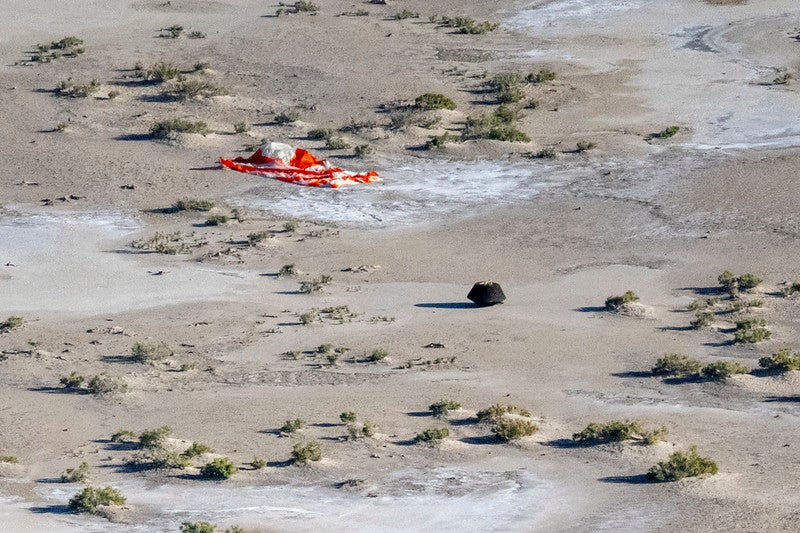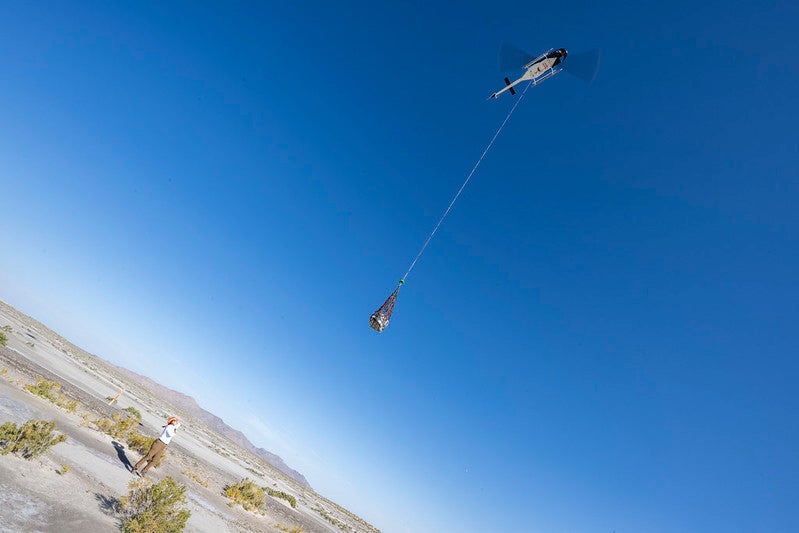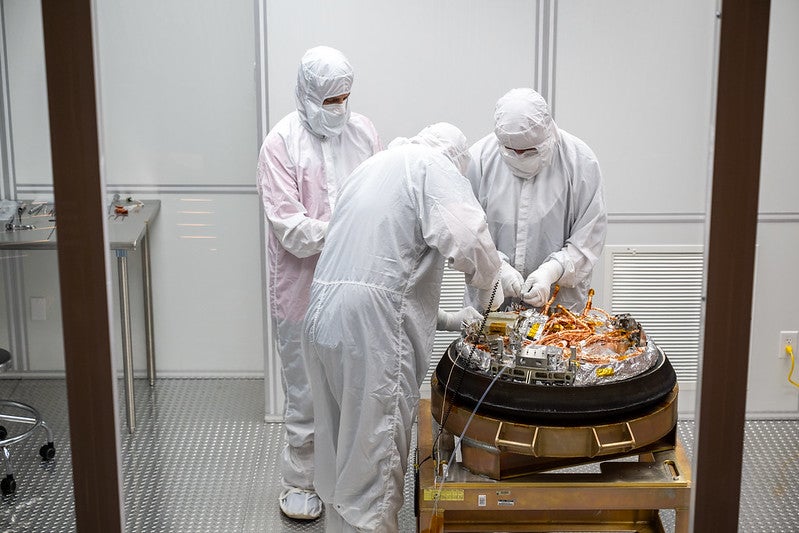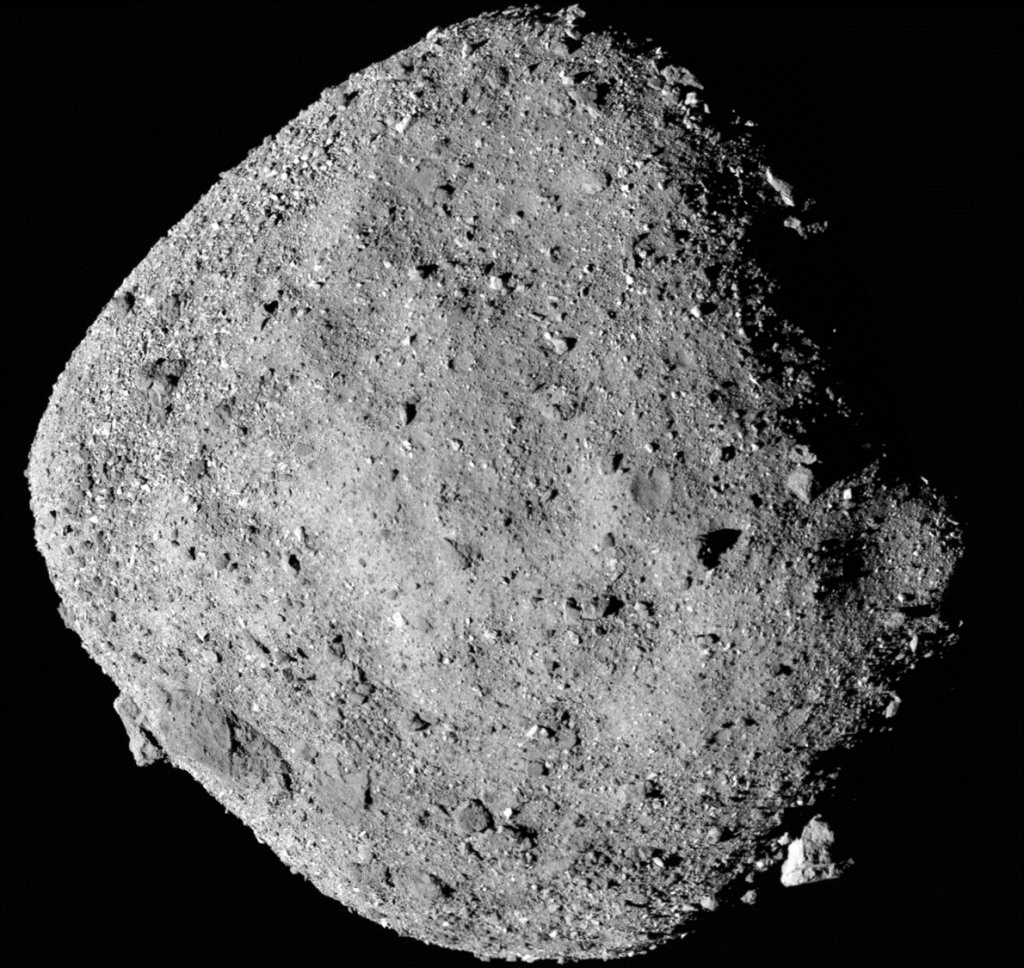
On Sept. 24, 2023, part of the asteroid belt hit Earth — safely under parachutes and inside a capsule. The Origins, Spectral Interpretation, Resource Identification, Security-Regolith Explorer — better known as OSIRIS-REx — has now successfully dropped off its collected pieces of the near-Earth asteroid Bennu.
The spacecraft’s six-year main mission culminated with the morning re-entry of the sample return capsule holding some eight ounces (227 grams) of primitive asteroid in its clutches. It landed at the Air Force’s Utah Test and Training Range, which lies within the U.S. Army’s Dugway Proving Grounds in Utah’s West Desert.
At 4:42 A.M. local time, when the craft was still some 67,000 miles (107,825 kilometers) from Earth officials considering both the safety of recovery crews and the survivability of the capsule had to make a call.
It was a go. That’s when the sample capsule released from the main spacecraft.
Safe landing
The desert — at turns rolling, flat, or rugged — is vast, home to wild horses, golden eagles, greasewood, and fourwing saltbush. “It’s a beautiful place to land a capsule,” said Rich Burns, the mission’s project manager at NASA’s Goddard Space Flight Center in Baltimore, Maryland, in a press release. He compared getting the capsule on the landing ellipse to throwing a dart and hitting a bull’s-eye from across a basketball court.
The recovery action began just after the Sun came up on a chilly first full day of fall. Four helicopters filled the air with choppy roar and the smell of aviation fuel as they took off from Dugway’s airfield, carrying the team that would prepare the capsule for transport.
According to Sandy Freund, with Lockheed Martin mission operations, four hours passed between the release and re-entry at 27,000 mph (43,450 km/h), with the capsule pulling 30 Gs. But under the main chutes, the capsule touched down at a gentle 11 mph (18 km/h) at 8:52 A.M. MDT, just a few feet from a gravel road.

The recovery team first visually inspected the capsule from a distance, taking external temperatures and testing for gases in the air and in the craft to determine whether it was safe for approach (an unexploded bolt or ruptured battery would not have been welcome). They then wrapped the capsule and nestled it into a cargo container. The assembly was put into a cargo net for a helicopter to ferry back to the air base, the capsule dangling on a 100-foot-long (30 meters) line.
What ensued was a technical ballet. The helicopter landed outside a hangar where, in an ordinary parking lot, recovery crew rolled the capsule to the hangar on a specially built cart. Throughout the process, personnel consulted each other, checked the capsule’s wrapping, and then, finally, politely knocked twice to gain entry. Inside, the craft was unwrapped so staff could to brush material off the burnt shell and clean the rolling cart’s wheels so no desert grit made its way into the temporary clean room beyond.
Finally, the cart was rolled up a short metal ramp to the clean room’s sealed doors. The capsule was carefully lifted into a second cart made of anodized aluminum, the color of gold. This cart had been used for the Stardust cometary sample return mission nearly 20 years ago, which landed at the same site. Lockheed took it out of storage because that capsule had been the same size as OSIRIS-REx.
Only then did some of Bennu enter the clean room.
Mission success
The clean room, a metal and polycarbonate-window shed set on a concrete floor, had interior pressure higher than the outside to prevent external contamination. NASA and mission logos flanked the front metal doors. Wearing three layers, “fully bunnyed” personnel took off the capsule’s backshell and other equipment. (The sample retrieval unit is inside a canister, which itself is inside the sample return capsule.) They attached a nitrogen purge that will continue to release nitrogen — an inert gas — through the sample canister being stowed in Houston. Apart from safely having the capsule in hand, attaching the purge was the day’s main goal. It will further safeguard against terrestrial contamination, said Nicole Lunning, the team’s curation lead.

Today, those precious bits of Bennu are scheduled to fly on a cargo plane to Ellington Air Force Base in Houston. From there, it’ll be driven to the Johnson Space Center’s Astromaterials Acquisition and Curation Office. That’s where processing of the sample will begin, culminating in its eventual distribution to researchers around the world at 60 different labs.
More immediately, as soon as Sept. 26, principal investigator Dante Lauretta tells Astronomy the team will wipe the canister walls for a “quick-look analysis.” They’ll be looking for clays, carbonates, and iron oxides to see whether the remote sensing instruments were on point when characterizing Bennu’s composition from orbit.
Lauretta was also part of the team that sampled the Utah desert immediately around the landing site to characterize those materials — dirt, air, water, etc. — in case any happened to infiltrate the seal (an event he called “unlikely”).
Picking up pieces
OSIRIS-REx launched Sept. 8, 2016, as the first U.S. asteroid sampling mission. It carried a suite of instruments including the touch-and-go sample acquisition mechanism, or TAGSAM. The mission also had planetary defense implications — as a near-Earth asteroid, Bennu has a small chance of hitting the planet in the next century.
Bennu is, as the space crow flies, about 200 million miles (321 million km) away; OSIRIS-REx arrived two years after launch. On Oct. 20, 2020, the truck-sized spacecraft sampled the young, 60-foot-wide (18 m) crater area Nightingale. Dust and pebbles were blown about as OSIRIS-REx touched down; the TAGSAM itself blew nitrogen gas at the surface to usher material into the sample container. Contact pads on the sampling arm also collected tiny particles before the craft backed off.
Ultimately, Lauretta says, the TAGSAM’s robotic arm actually went into the asteroid some 20 inches (50 centimeters), up to its elbow joint, packing the sample mechanism and initially jamming the closure flap with a rock just 1.2 inches (3 cm) wide. The team was able to stow the sample in the return capsule a week later.
In spring 2021, OSIRIS-REx’s engines burned for home. Earlier this month, the craft first made a final Earth-targeting burn, along with a later small course correction, bringing it into position to release the capsule for re-entry.
Later, Lauretta called the landing “pulse-pounding. Boy, did we stick that landing! It didn’t move, it didn’t roll, it didn’t bounce.” He says that during re-entry, the entire sample could have been jostled so much that “it could all be powder” by the time it landed — though that won’t affect researchers’ ability to analyze the materials. More will be known soon but he joked that his curation team “wouldn’t let me shake it.”
Precious cargo
About 1/3 mile (0.5 km) in diameter, Bennu is a carbonaceous asteroid that has changed little in 4.5 billion years. Meteorites from carbonaceous asteroids are rare and valuable, containing organic molecules, hydrocarbons and amino acids — elements necessary for life as we know it. Some even have water.

Bennu’s samples will be even more pristine than those in meteorites. That’s because the material won’t have traveled through Earth’s atmosphere unprotected nor landed exposed on the surface our of world, open to the elements for potentially years before discovery and retrieval.
OSIRIS-REx has now given us the largest sample returned from a body beyond the Moon, according to NASA planetary scientist Melissa Morris. The sample will take us “back to the dawn of the solar system,” says Lauretta, noting its material contains the “seeds of life” and will help illuminate how prebiotic chemistry eventually got us to life on Earth.
Lauretta thinks Bennu is about 10 percent water (not liquid but locked up in rock), along with 5 percent carbon by weight. He stresses there’s a “vanishingly small probability” there’s biotic material. But the sample could show the state that occurs between an organic molecule and life itself.
Lauretta and others are particularly keen on the record of Bennu’s parent body, which formed only a few million years after the origin of the solar system. That parent body had hydrothermal deposits like those of Earth’s deep-ocean environments, according to Lauretta. Its water helped form such substances as clay. It might also have formed long-chain organic molecules, including amino acids, which are vital for the formation of peptides. In all the meteorites collected on Earth, only one, Lauretta says, has “a hint” of a simple peptide.
It would be a stunning first if the sample material yields such a discovery. Danny Glavin, Senior Scientist for Sample Return at NASA’s Goddard Space Flight Center, says he and his team will be looking for just that long shot. “It’s one of the first things to look for,” he says, adding, “we’re going to go after them hard.”
Asteroid Autumn
Now the OSIRIS-APEX for Apophis Explorer, the mission is heading to that asteroid for a 2029 rendezvous. The 1,200-foot (370 m) world will come within 20,000 miles (32,000 km) of Earth that year, and researchers hope to study how Apophis might be perturbed by the encounter. The team also plans on using the spacecraft’s thrusters to blow material from the surface to study with onboard instruments.
The golden age of asteroid research seems to be upon us. Two Japanese missions have previously retrieved asteroid samples, though not from a carbonaceous world like Bennu. The DART mission successfully demonstrated planetary defense techniques by moving an asteroid’s orbit. Psyche will launch later this year on a mission to a metallic asteroid, and NEO Surveyor, scheduled to launch in 2028, will hunt from space for potentially hazardous asteroids.
With the Bennu sample return and the upcoming the Psyche launch and Lucy flyby of Dinkinesh, NASA is calling this season “Asteroid Autumn.”
For Lauretta, this autumn is both busy and full of relief. He cried when the main chutes deployed, especially since it was not clear that the drogue chutes had opened first. Soon, he will get to analyze the samples, which NASA says will be safely protected in the event of a government shutdown.
But first: a mission celebration party in Tucson. “We’re going to throw down,” he says.









